| DETECTED CONDITION | POSSIBLE CAUSE | ||
| C21 | Output voltage is not within the following range. | IAT sensor circuit open or short IAT sensor malfunction | |
| P0110 | 0.15 V Sensor voltage < 4.85 V | ECM malfunction | |
| P0110 | H | Sensor voltage is higher than specified value. | IAT sensor circuit open or ground circuit open |
| L | Sensor voltage is lower than specified value. | IAT sensor circuit shorted to ground | |

Inspection
Step 1 (When indicating C21:)
- 1) Turn the ignition switch OFF.
- 2) Remove the fuel tank. (6-3)
- 3) Check the IAT sensor coupler for loose or poor contacts.
If OK, then measure the IAT sensor voltage at the wire side coupler.
- 4) Disconnect the coupler and turn the ignition switch ON.

- 5) Measure the voltage between Dg wire terminal A and ground.
- 6) If OK, then measure the voltage between Dg wire terminal A and B/Br wire terminal B.
- IAT sensor input voltage: 4.5 - 5.5 V
- (+ Dg - − Ground)
- (+ Dg - − B/Br)
- 09900-25008: Multi-circuit tester set
- Tester knob indication: Voltage
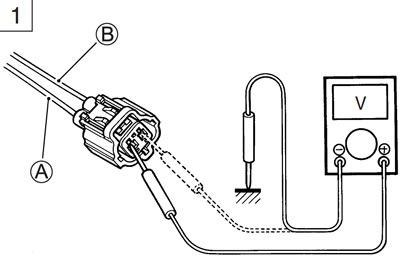
Is the voltage OK?
| YES | Go to Step 2. |
| NO | Loose or poor contacts on the ECM coupler (terminal 27 or 29) Open or short circuit in the Dg wire or B/Br wire |
Step 1 (When indicating P0110-H:)
- 1) Turn the ignition switch OFF.
- 2) Remove the fuel tank. (6-3)
- 3) Check the IAT sensor coupler for loose or poor contacts. If OK, then check the IAT sensor lead wire continuity.
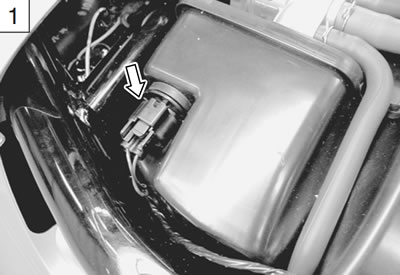
- 4) Disconnect the IAT sensor coupler and ECM coupler. (5-37)
- 5) Check the continuity between Dg wire A and terminal 27.
- 6) Also, check the continuity between B/Br wire B and terminal 29.
Caution: When using the multi-circuit tester, do not strongly touch the terminal of the ECM coupler with a needle pointed tester probe to prevent the terminal damage or terminal bend.
- IATS lead wire continuity: Continuity (•)))
- 09900-25008: Multi-circuit tester set
- 09900-25009: Needle pointed probe set
- Tester knob indication: Continuity test (•)))
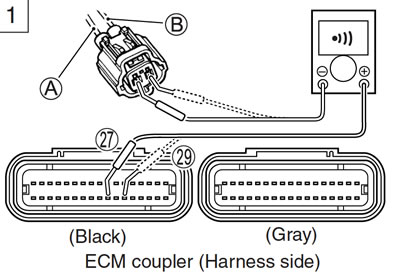
Is the continuity OK?
| YES | Go to Step 2. |
| NO | Dg wire or B/Br wire open |
- 7) After repairing the trouble, clear the DTC using SDS tool. (5-26)
Step 1 (When indicating P0110-L:)
- 1) Turn the ignition switch OFF.
- 2) Remove the fuel tank. (6-3)
- 3) Check the IAT sensor coupler for loose or poor contacts. If OK, then check the IAT sensor lead wire continuity.
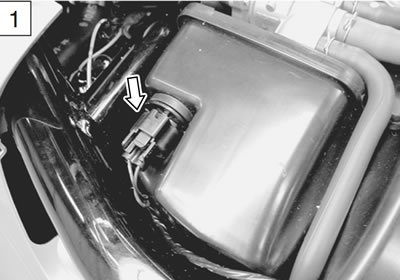
- 4) Disconnect the IAT sensor coupler.
- 5) Check the continuity between Dg wire А and ground. If the sound is not heard from the tester, the circuit condition is OK.
- Tester knob indication: Continuity test (•)))

- 6) Connect the IAT sensor coupler and turn the ignition switch ON.
- 7) Measure the voltage between Dg wire А and ground.
- IAT sensor output voltage: 0.15 - 4.84 V
- (+ Dg - − Ground)
- 09900-25008: Multi-circuit tester set
- 09900-25009: Needle pointed probe set
- Tester knob indication: Voltage
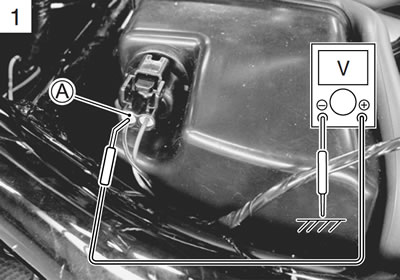
Are the continuity and voltage OK?
| YES | Go to Step 2. |
| NO | Dg wire shorted to ground If wire is OK, go to Step 2. |
- 8) After repairing the trouble, clear the DTC using SDS tool. (5-26)
Step 2
- 1) Turn the ignition switch OFF.
- 2) Measure the IAT sensor resistance.
- IAT sensor resistance: Approx. 2.45 kΩ at 20°C (68°F) (Terminal - Terminal)
- 09900-25008: Multi-circuit tester set
- Tester knob indication: Resistance (Ω)
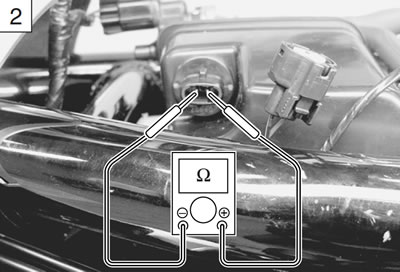
Is the resistance OK?
| YES | Dg or B/Br wire open or shorted to ground, or poor 27 or 29 connection If wire and connection are OK, intermittent trouble or faulty ECM. Recheck each terminal and wire harness for open circuit and poor connection. Replace the ECM with a known good one, and inspect it again. |
| NO | Replace the IAT sensor with a new one. |

IAT sensor specification
| Intake Air Temp | Resistance |
| 20°C (68°F) | Approx. 2.45 kΩ |
| 80°C (176°F) | Approx. 0.322 kΩ |
| 120°C (248°F) | Approx. 0.117 kΩ |
Note: IAT sensor resistance measurement method is the same way as that of the ECT sensor. Refer to page 8-9 for details.
